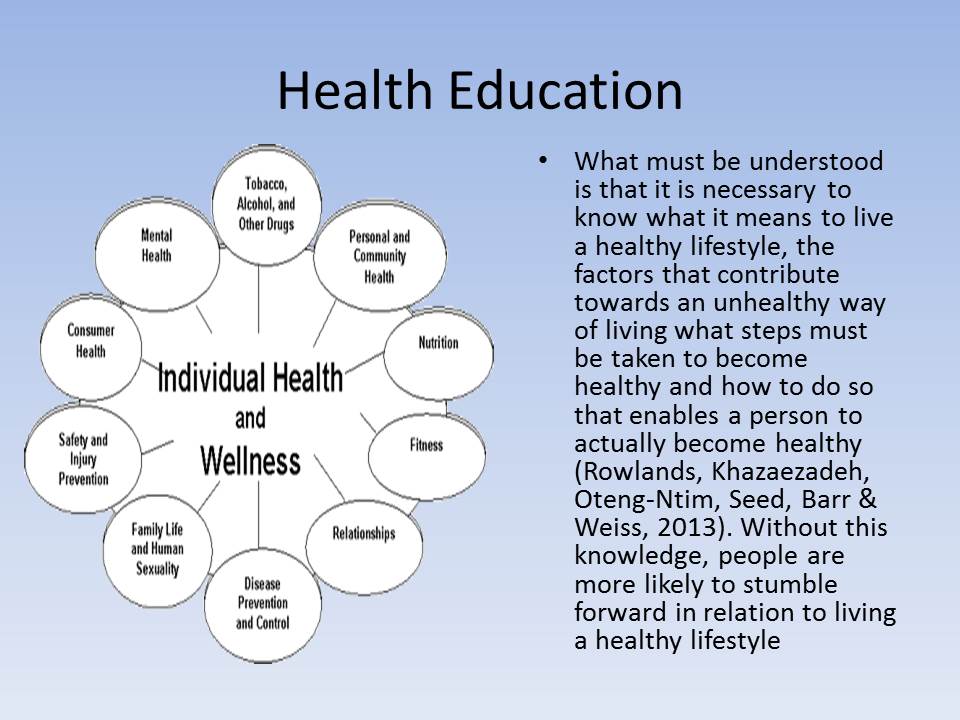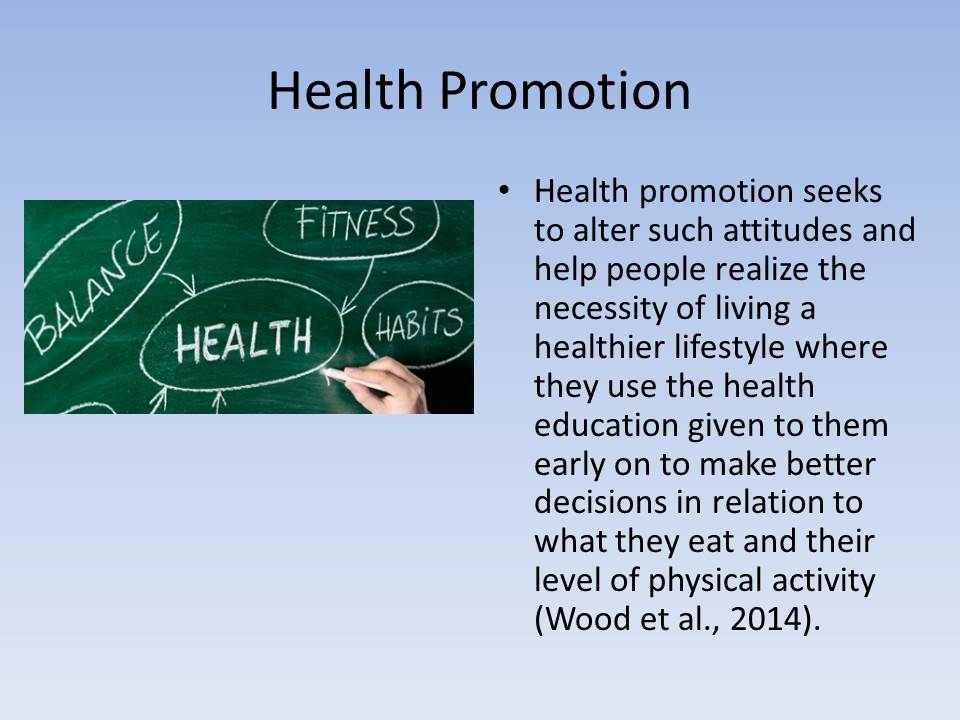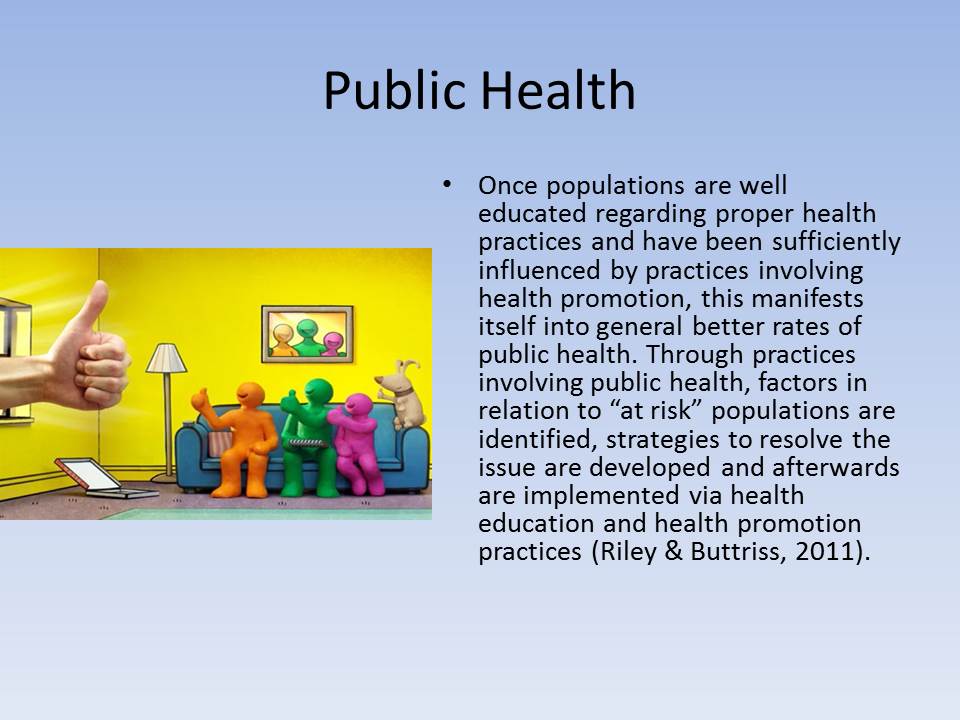Introduction
The relationship between public health, health promotion and health education is an interesting one yet has humble origins that begin within with your average school. The relationship between the three factors is progressive, in that it seemingly looks like a pyramid with public health situated at the very top while health education is at the base of the pyramid.
- Public Health;
- Health Promotion;
- Health Education.

Health Education
What must be understood is that it is necessary to know what it means to live a healthy lifestyle, the factors that contribute towards an unhealthy way of living what steps must be taken to become healthy and how to do so that enables a person to actually become healthy (Rowlands, Khazaezadeh, Oteng-Ntim, Seed, Barr & Weiss, 2013). Without this knowledge, people are more likely to stumble forward in relation to living a healthy lifestyle.
First and foremost, what must be understood is that health education acts as the base of the pyramid since it is the primary means by which people learn how to eat and be healthy. What must be understood is that it is necessary to know what it means to live a healthy lifestyle, the factors that contribute towards an unhealthy way of living what steps must be taken to become healthy and how to do so that enables a person to actually become healthy (Rowlands, Khazaezadeh, Oteng-Ntim, Seed, Barr & Weiss, 2013). Without this knowledge, people are more likely to stumble forward in relation to living a healthy lifestyle and would tend to assume the general misleading hype that is currently being promoted by the mass market in relation to what you are eating (ex: a calorie is a calorie – a completely false method of advertising proper eating habits) (Rowlands et al., 2013).

Health Promotion
Health promotion seeks to alter such attitudes and help people realize the necessity of living a healthier lifestyle where they use the health education given to them early on to make better decisions in relation to what they eat and their level of physical activity (Wood et al., 2014).
Health promotion consists of the various campaigns conducted by governmental and nongovernmental organizations in relation to developing healthy lifestyles and eating habits. This practice builds upon the knowledge gained from health education, yet focuses on changing attitudes in relation to being healthy. What must be understood is that one of the primary detrimental factors towards leading a healthy lifestyle is your general attitude towards it. While a person may know what is healthy and what is not, a large percentage of the population still continues to practice unhealthy habits (ex: smoking and binge drinking soft drinks despite the fact that you know its bad for you) (Hilton, Wood, Patterson & Katikireddi, 2014). Health promotion seeks to alter such attitudes and help people realize the necessity of living a healthier lifestyle where they use the health education given to them early on to make better decisions in relation to what they eat and their level of physical activity (Wood et al., 2014).

Public Health
Once populations are well educated regarding proper health practices and have been sufficiently influenced by practices involving health promotion, this manifests itself into general better rates of public health. Through practices involving public health, factors in relation to “at risk” populations are identified, strategies to resolve the issue are developed and afterwards are implemented via health education and health promotion practices (Riley & Buttriss, 2011).
The two aforementioned factors of health education and health promotion manifest themselves in general public health. Once populations are well educated regarding proper health practices and have been sufficiently influenced by practices involving health promotion, this manifests itself into general better rates of public health. Through practices involving public health, factors in relation to “at risk” populations are identified, strategies to resolve the issue are developed and afterwards are implemented via health education and health promotion practices (Riley & Buttriss, 2011). There are several examples of this that can be seen in the UK, for instance, there is the current issue of the growing rate of obesity within the country which was identified some time ago. In order to address this problem, health education campaigns aimed at children and young adults were created after which new health promotion campaigns were subsequently implemented via advertisements, leaflets etc. The end result was a generally far more educated younger population that understood what methods needed to be implemented in order to lead healthier lifestyles and were generally encouraged to do so via the various promotional campaigns that highlighted the dangers that obesity presented which could kill them in the long run (Riley & Buttriss, 2011).

Reference List
Hilton, S., Wood, K., Patterson, C., & Katikireddi, S. (2014). Implications for alcohol minimum unit pricing advocacy: What can we learn for public health from UK newsprint coverage of key claim-makers in the policy debate?. Social Science & Medicine, 102157-164.
Riley, H. H., & Buttriss, J. L. (2011). A UK public health perspective: what is a healthy sustainable diet?. Nutrition Bulletin, 36(4), 426-431.
Rowlands, G., Khazaezadeh, N., Oteng-Ntim, E., Seed, P., Barr, S., & Weiss, B. D. (2013). Development and validation of a measure of health literacy in the UK: the newest vital sign. BMC Public Health, 13(1), 1-9.